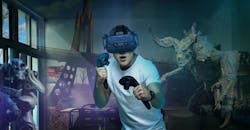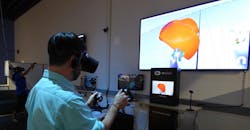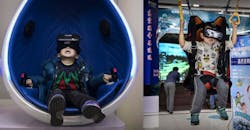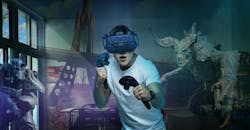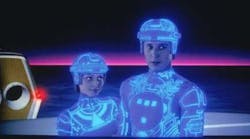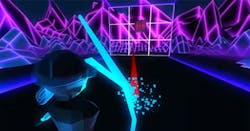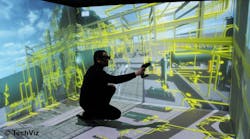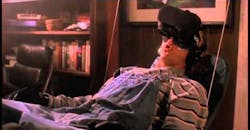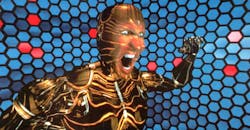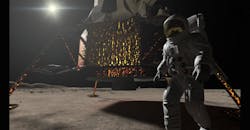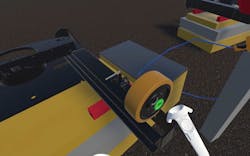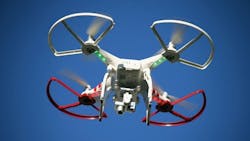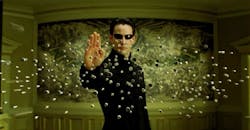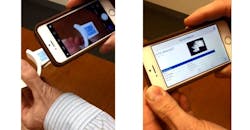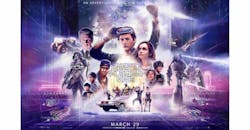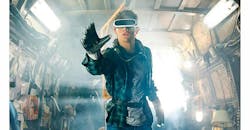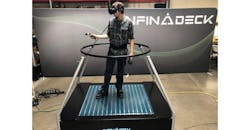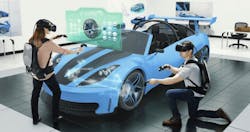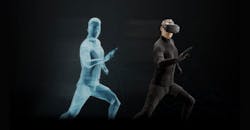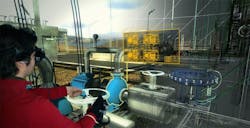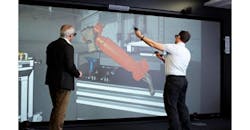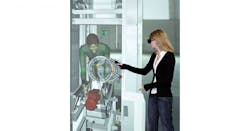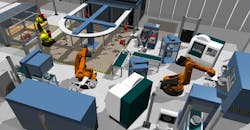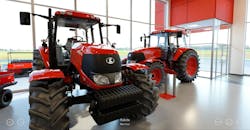A different version of this article previously appeared on IndustryWeek.
Immersive virtual reality has been promised for a long time, and it’s made great leaps forward in the last few years. It first appeared in various forms throughout the 20th Century, most visibly in science-fiction movies that posed the question: if we can escape to a virtual world, should we?
It’s the premise of Steven Spielberg’s latest futuristic popcorn romp, "Ready Player One," and it’s a question manufacturing leadership should ask themselves.
Between the flashes of pop culture references and kinetic CGI battles, the question does sort of get answered in the movie. VR, like any tech, is not inherently good or bad; it all depends on how it’s used and how often. Unless you’re as cartoonishly evil as the CEO from the flick, we doubt your implementation of VR would be “bad,” but it could be unnecessary.
Strong industrial use cases exist right now for design and engineering, with CAD files and blueprints jumping off the screen (or you jumping into the screen) for you to manipulate. We are merely at the pioneer stage of exploring the new digital frontier, though, with a whole lot more to discover and invent. Here’s a quick rundown of where we’ve been and where we are now, which should give you an idea of what VR cases you should get a closer look.
Falling Prices
The Oculus Rift and Touch dropped from $799 to $399 in one year. I tried one out at the Tech Museum of Innovation in San Jose, Calif., and the controls were fairly intuitive to use for someone who has been playing video games for around 35 years.
Wave of the Future Worker
Using this VR tech will be incredibly easy to pick up by your new workforce—you know, the ones who will replace all the retiring Baby Boomers. Manufacturers that develop and deploy new VR-assisted applications will easily attract the most talented, outside-the-box thinkers, as well as shed the stigma of being “dirty, dumb, and dangerous.”
Media Influence
While post-Millennials will have grown up with the tech, the current engineers developing the hardware and software and executives driving strategy were likely first introduced to VR via entertainment, from video games to movies, as the real thing was so poorly executed due to lack of computing power and primitive graphics. Looking at a few of of the more culturally relevant fictional use cases, it appears those seeds have gestated into real tech that can help manufacturers today.
Tron (1982)
The first example of a computer-created virtual reality system was only 14 when "Tron" came out in 1982. Arcade games were even newer. The two technologies, along with A.I., merged to drive the plot of a computer programmer entering the world he coded, forced to fight for his life in games just a step above Pong in simplicity.
Gamification
Tron was ridiculous, but we all wished we could play those games instead of wiggling around a joystick. Now we can, as a few modern VR games bear a striking resemblance to "Tron's" games, such as Holoball for the HTC VIVE. One of the first rules of widespread adoption is to make fun games consumers will use. Think of how Pokemon GO put augmented reality in the mainstream vernacular.
Star Trek: The Next Generation (1987)
The Holodeck was a place for the Starship Enterprise crew to wind down after a long day of boldly going places, and some would get addicted to the escapist fantasies they could program into the holodeck, an entire virtual reality room comprised of holograms. They often played out like a PG-rated "Westworld."
Plant Design: The Next Generation
Using programs such as TechViz XL, you might also get addicted. It allows an engineer to visualize what they build in a native 3D application, and tweak designs that are updated instantly. This allows the team to detect errors and optimize space before a new production line is installed or the facility is expanded.
The Lawnmower Man (1992)
In this loose adaptation of a Stephen King novel, a doctor decides the best person to try out his IQ-enhancing VR program is an abused mentally challenged landscaper. So far, so good...
But then the subject develops crazy mind powers and a God complex. Chaos ensues.
Learning by Doing
Immersive VR Education also aims to use VR as a training tool, explaining that learning by doing is the optimal way to retain knowledge, citing Edgar Dale’s model that people remember 90% of what they say and do two weeks later after doing or simulating an action. And users will remember a lot longer than that after running through the Apollo 11 moon landing simulation the company made.
Training Assembly Workers
Toyota deployed a pilot project with the software company Reality Matters to train assembly workers using the HTC VIVE to teach hand movements and IT systems operation. The training program went from "concept, to prototyping and pilot validation," Reality Matters says, and increased worker motivation and attention.
Disclosure (1994)
This Michael Crichton-penned tale features the unlikely notion that VR would be used to access data bases. Because putting on gloves and goggles every time you want to check out an operations reports is much more efficient than clicking on a spreadsheet, right? It did get right that external vision sensors are needed to accurately pick up on body movements in the virtual world.
Motion Tracking on the Go
If using these sensors, they have to stay at fixed points. But Qualcomm's IoT department hinted that this could be done soon by drones hovering around the user, allowing for more movement.
“You don’t want to calibrate each room,” says Jim Merrick, director of marketing for Qualcomm's IoT business. “Instead, you can use the Snapdragon camera and [Visual Inertial Odometry] to track the position of the VR headset. It’s that precise, just looking at what it sees in the room, and know if you’re moving forward or back, up, down, left or right.”
The Matrix (1999)
The virtual world here is so realistic, you don’t even know it’s fake. It took an omnipotent artificial intelligence to create it, and even with Moore’s Law, it will be many decades before we have anything even close. Instantly downloading knowledge instead of spending years in college would be convenient, though.
Linking Physical and Virtual Parts
A new strategy by 3D-printing company Rize also has the ambition of melding the digital and physical worlds. It uses a hybrid jetting/extrusion process to tattoo a QR code onto a physical part, a signature that connect it to a digital twin. An engineer can print a part and see a need to tweak the form. They can scan the code, which will direct them to the Dassault Systemes CATIA V5 CAD file to virtually manipulate the digital twin.
Ready Player One (2018)
"Ready Player One" is probably the best representation of VR onscreen, which it should be considering how close it is to becoming science non-fiction. Considering how prescient Steven Spielberg’s "Minority Report" was for a 2002 film (based on the 1956 short story by Philip K. Dick), including autonomous cars, gesture control, and targeted marketing-based on facial scans, it’s worth a view to spur some ideas.
You may find the vision of Columbus, Ohio circa 2045 to offer the most valuable insights. This is a place where people can link to the high tech OASIS from the dingiest of “high-rise” trailer parks. The young protagonist Wade Watts even has an omni-directional tread mill so he can run and jump around a borderless sandbox without going anywhere at all. And when he gets the high score, he earns enough to buy a state-of-the art suit to allow him to feel what happens to him inside the OASIS.
Real Omni-Directional Treadmill
You don't have to wait for 2045 for this tech now. Infinadeck is beta testing its 360° moving floor right now and doesn’t requires a harness or special shoes. With this, a plant walk-through can literally be done from the corporate office. Or throw on a zombie simulator and run off that big lunch... and have infinite nightmares as a bonus.
Power Up with VR Backpack
The HP Z VR backpack boosts near lifelike VR experiences with no strings attached (or power cords). The wearable computer is decked out with powerful GPU and processor, along with a hot-swappable battery, to provide ultimate mobility for whatever the application.
Hooked on a Feeling
So you have a treadmill and powerful VR computer, but a haptic feedback suit (like the one made by Teslasuit) really shows you love your job, or hate reality. Either way, this suit can even change temperature so if you're virtually inspecting cold storage, the climate-control feature could blast you with a cold sensation.
Ready Player Two
With or without the fancy gear, the virtual manufacturing world is open for business, and collaboration. AVEVA, which recently merged with Schneider Electric Software Business, uses its Activity Visualisation Platform to connect manufacturing workers, such as control room operators, with maintenance techs in a combined environment. This can be for sessions on learning new equipment, safety training, or for maintenance planning and execution. AVEVA says this is intended to "support the capture and knowledge transfer of best practices, increasing efficiency while reducing costly errors and maintenance costs."
Real Results
ESI's solution IC.IDO has been used by GABLER, a manufacturer of production lines for candy and pharmaceutical pellets to get an idea of how the line operate. They can exceed 200 feet and be lined with complex equipment.
"With IC.IDO we can check every single corner of the manufacturing line, remove any piece of the machine, and replace it by another," says Patrick Gabler, Engineering Project Manager. Thus, we are able to check manufacturing feasibility and serviceability from the earliest steps of the product lifecycle management.”
Real Results
Looking at 3D model is one thing, but walking around a digital doppleganger, that requires no physical material, is another.
“Using IC.IDO in this project allowed us to meet our deadline and to deliver the expected quality in a lead time about 15% shorter than for other comparable projects,” Gabler says.
Addictive Behavior
Even if the last game you played was Pac-Man, there's a VR application that will give your workers a new kind of fever. With the ability already to build a 3D factory simulation (CIROS Studio pictured) and test out how different set ups can affect yields and production, it won't be long before the C-Suite can investigate real-time data at any plant by interacting with a digital twin in the virtual world. And the more you can understand your business, the better the chance you have at winning.
Virtual Interior Design
Office interior designer Mayhew has deployed Yulio's VR platform to help customers "see" a show room before anything is installed or painted. it's so realistic, you may think this Kubota dealership is real. It's totally digital. And as solutions like this evolve, they will ensure every plant, from the assembly line to overall layout, it optimally designed for safety and efficiency.
About the Author
John Hitch
Senior Editor
John Hitch writes about the latest manufacturing trends and emerging technologies, including but not limited to: Robotics, the Industrial Internet of Things, 3D Printing, and Artificial Intelligence. He is a veteran of the United States Navy and former magazine freelancer based in Cleveland, Ohio.
